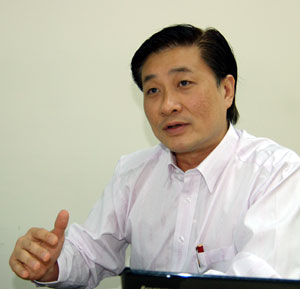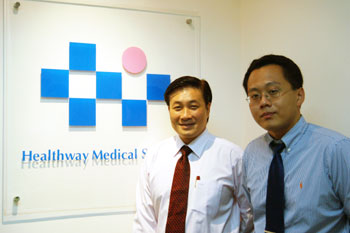
LONG QUEUES at the doctor’s as the H1N1 virus spreads in the community may be a good reason market interest has warmed up towards listed Healthway Medical Group. From a lethargic trading range of 5.5-6.5 cents in March, the stock has woken up and traded in the 12.5-15 cent recently.
The spike in flu and vaccination cases happened in July and August, along with the sale of Tamiflu and protective consumables. That has kept Healthway busy, likely more so than its listed peers as Healthway operates the biggest chain of general practitioner clinics in Singapore.
While Healthway does not operate a hospital, most of its listed peers do – which could be a negative for them because an escalation of the H1N1 outbreak, as a recent Nomuara Singapore report noted, could cause patients to postpone elective procedures to avoid visiting hospitals.
The epidemic has since subsided but global health authorities are bracing themselves for the next wave in the coming months as winter blankets the northern hemisphere. Healthway doctors may find themselves coping with another surge in flu cases.
Listed in July 2008, Healthway employs over 160 full-time doctors and it fully owns 84 clinics, which represent 11 medical practices ranging from family medicine and dentistry to paediatrics and orthopaedics.
They operate under brand names such as Healthway, Silver Cross, Neu Glow (The Aesthetics Doctors), Singapore Baby & Child Clinic and Island Orthopedic Consultants.
Sixty of the group’s clinics offer primary healthcare – that is, family medicine and dentistry – and they are located largely in HDB estates islandwide.
Intending to boost its dominance in the primary healthcare sector, Healthway will double its primary healthcare clinics to 120 in three to four years’ time, says Dr Wong Weng Hong, its managing director (medical services), in an interview with Pulses.
|
To do so, Healthway will mainly start ‘greenfield’ clinics, instead of acquiring existing practices as it has done in the past, he says. The money for that will come from its own funds, bank loans and, perhaps, institutional investors.
Partly to conserve cash, Healthway has offered shareholders an option to receive scrip dividends, instead of cash, for the final dividend (0.12 cent a share) of 2008 and for the interim dividend (0.12 cent a share) this year.
Reflecting its focus on outpatient healthcare close to the community, Healthway has no plans to start or acquire a hospital – not when 80 per cent of the healthcare expenditure in Singapore now takes place outside of hospitals, notes Dr Wong.
Furthermore, within the hospitals, a lot of healthcare expenditure is for doctor or healthcare services, rather than for the use of facilities, he adds.
Driving the trend of healthcare services being provided on an outpatient basis and closer to where patients live are advances in technology: Medical equipment have become more compact and portable and improved in many respects.
Citing an example, Dr Wong, 45, who co-founded Healthway in 1990, said; “When I was a medical student, endoscopy using rigid tubes had to be done in the hospital. It was painful and the risk of complications was high. Now with flexible tubes, endoscopy can be done on an outpatient basis in the doctor’s office.”
Endoscopy is a minimally invasive diagnostic procedure to assess the interior surfaces of an organ by inserting a tube into the body.

Quality training of doctors has also helped bring many services closer to the community. So have lower prices as medical procedures done in a setting within the community tend to cost less than in hospitals as, among other reasons, the infrastructure costs less, notes Dr Wong, who obtained his medical degree from the National University of Singapore and a Master of Business Administration from the Macquarie Graduate School of Management, Australia.
Raffles Medical is the closest competitor to Healthway but they differ in a significant way. Raffles is by far more focused on corporate clients – it has 5,500 while Healthway has more than 1,000 – and derives about 90 per cent of its revenue from attending to the employees of its corporate clients.
Healthway, on the other hand, counts about 80 per cent of its primary healthcare revenue coming from cash-paying patients. “The advantage of that is we have good cashflow as we don’t have to wait a few months for our payment. And the profit margin is slightly better,” says Dr Wong.
“While we want to grow our corporate client business, our DNA is different from Raffles which focused on corporate clients from the start while we are a community-based family practice with a large following of cash-paying patients.”
Given that 60 of its 84 clinics offer primary healthcare, investors may think that Healthway derives most of its revenue from such outlets. That is the case: Last year, primary healthcare contribution to revenue in 2008 was 62 per cent. However, it contributed only 38 per cent of the pre-tax profit while its specialists services contributed the remaining 62 per cent.
Which is why, while Healthway wants to grow its general practitioner business, it is stepping up its efforts also to widen its range of specialist services and increase the number of specialist clinics.
Unlike specialist clinics run by sole proprietors, Healthway’s specialist businesses enjoy the distinct advantage of getting a good flow of patient referrals from Healthway’s own vast network of primary healthcare clinics.
4,000 walk-in patients a day
Dr Tan Say Lock, 31, deputy medical director (manpower/special projects), explains: “We have about 4,000 walk-in patients a day at our GP clinics. Let’s say 50 of them have an eye problem, 100 of them have ENT (ear, nose and throat) problems. Some of these problems cannot be handled at the primary healthcare level and have to be referred to specialists. By monitoring the numbers, we will know the level of demand and decide to set up our own specialist clinics.”
On the trigger point for Healthway to set up its own specialist clinic, Dr Wong says: “If we feel this service can generate $100,000 a month, then it’s about time to start our own practice. We can more or less break even at that level.”
In July, Healthway introduced its ENT and eye specialist services. In October, it will start to offer general surgery services. For all new services, Healthway sets up the centres, equips them and hires the specialists.
Specialists join Healthway because the business kick-starts stronger. “Our experience is that our ramp-up is 2-3 times faster than a specialist setting up on his own. Reason is we have a strong pool of primary healthcare patients whom we can refer to our specialists,” says Dr Wong.
And given the better business prospects, Healthway can afford to offer a higher starting salary to these specialists, he adds. “Getting enough doctors is not an issue.”
Chips in Dr Tan: “The truth is, many doctors find it difficult to survive on their own.” In comparison, Healthway enjoys positive operating cash flow to the tune of $8 million in the first half of this year.
As at 30 June 2009, the group had cash and cash equivalents amounting to $28.1 million, inclusive of a bank overdraft of $1.0 million and pledged fixed deposits of $20.0 million.
Another challenge for sole proprietors of medical practices: “If they are on their own, they don’t have time for professional development. But at Healthway, we provide medical education activities, get sponsorship for training and upgrading of skills. This is especially important for specialists,” says Dr Tan.
Within its range of specialist services, Healthway has achieved the distinction of being the largest paediatric clinic chain in Singapore following its acquisition of the Singapore Baby & Child group, which has 11 clinics, in June last year.
It wants to grow more. “We already have a presence in all the major private hospitals, except East Shore, but we want a greater presence in the community. There are gaps we can fill and these days people can afford to pay,” says Dr Tan.
Healthway is also the largest orthopaedic chain with six clinics. Another interesting plan Healthway has is for large centres of between 10,000 sq ft and 20,000 sq ft with various specialists under one roof catering to both local and foreign patients.
Healthway’s vision is for such a centre to be user-friendly in so far as the foreign patients do not feel lost and overwhelmed if they come to see the specialists and have to be subjected to a battery of tests.
Currently and unfortunately, that is how foreign patients seem to feel when they patronise some private hospitals in Singapore, as they are required to go to different floors to see the specialists for various tests, says Dr Wong.
“We need to provide an answer to Thailand, which now gives foreign patients a very good total experience. All along in Singapore, we have focused on the medical outcome – you come to me as a patient, and I will make sure you get well. But we have not focused on their total experience when they are here.”
Asked if a site has been identified, he quips: “We have some sites in mind – but maybe not Sentosa!”
In the first half of this year, Healthway enjoyed a 47.4 per cent year-on-year jump in revenue to $48.1 million, an increase largely attributable to the contribution from the Island Orthopaedic Group and the Singapore Baby & Child Clinic group acquired in June 2008.
Similarly, the acquisitions have boosted the net profit – it soared to $8.1 million, an 81.2 per cent increase, which can also be partly attributed to the non-recurrence of S$2.5 million in costs for professional services required in the first half of 2008 mainly due to the various acquisitions of clinics as well as the Healthway’s initial public offer exercise.
Quarter-on-quarter, revenue in the second quarter of this year increased 3.2 per cent but net profit rose faster at 15 per cent to $4.34 million.
The longer-term growth drivers for the business are the same here as in other countries in the region, including an ageing and growing population, greater participation in sports, and higher education levels.
“Something different about Singapore – a lot of government initiatives such as releasing Medisave savings for use in treating several chronic illnesses in private clinics, and a conscious and active effort to divert patients from the public hospitals to the private clinics,” notes Dr Wong.
“If you live long enough you will get cataracts. It’s an age-related matter,” quips Dr Tan.
Adds Dr Wong: “Demand for healthcare services cannot come down, it can only go up. It’s not like electronics goods, whose demand can rise and fall.”
|
||
This article was recently published in Pulses magazine and is reproduced here with permission.







